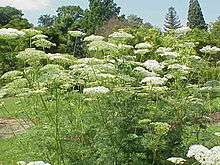Cnidium
Cnidium is a genus of flowering plant in the Apiaceae, native to Eurasia, Africa and North America. It has 4 or 5 species. Cnidium monnieri (L.) Cuss. is one of the most widely used traditional herbal medicines and its fruits have been used to treat a variety of diseases in China, Vietnam, and Japan. As of this writing, 350 compounds have been isolated and identified from C. monnieri, including the main active constituent, coumarins. In vitro and in vivo studies suggest that osthole and other coumarin compounds possess wide range of pharmacological properties for the treatment of female genitals, male impotence, frigidity, skin-related diseases, and exhibit strong antipruritic, anti-allergic, antidermatophytic, antibacterial, antifungal, anti-osteoporotic effects. Although coumarins have been identified as the main active constituents responsible for the observed pharmacological effects, the molecular mechanisms of their actions are still unknown.[1]
| Cnidium | |
|---|---|
 | |
| Cnidium silaifolium | |
| Scientific classification | |
| Kingdom: | |
| (unranked): | |
| (unranked): | |
| (unranked): | |
| Order: | |
| Family: | |
| Tribe: | |
| Genus: | Cnidium |
| Species | |
|
among others:
| |
Cnidium Rhizoma
References
- Li YM; et al. "Cnidium monnieri: A Review of Traditional Uses, Phytochemical and Ethnopharmacological Properties". Am J Chin Med. 43: 835–77. doi:10.1142/S0192415X15500500. PMID 26243582.